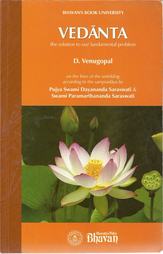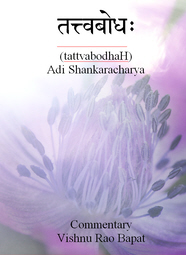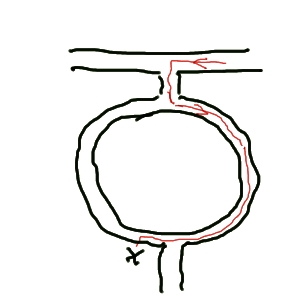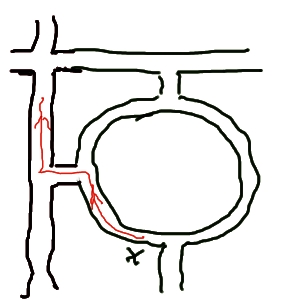Q: What is the relationship between memory and superimposition (adhyAsa)? In the metaphor of rope and snake, we say that we fail to see the snake clearly, because of inadequate light – there is partial knowledge and partial ignorance. When we superimpose a snake on the rope, we are drawing on fear and memory. We must have seen a snake (or image of one in a film or book) before in order to be able to mistake the rope for one. Similarly, we mistake brahman for the body and the world etc.
But what about a baby or someone who has no memory as a result of brain damage? Is there still superimposition in this case?
Responses from Ted, Venkat, Ramesam, Martin, Sitara and Dennis
A (Ted): We have to bear in mind that the example of a rope being mistaken for a snake is an analogy, and as is the case with any analogy, the example is imperfect. In the example, the snake image is based on a previous experience of the mistaken perceiver.
In terms of mistaking the body-mind-sense complex as well as the innumerable other objects that constitute the manifest universe for Brahman, however, we are dealing with something a little bit different. Whereas in order to mistake the rope for a snake, one must have previously seen a snake, the projection of the apparent reality (i.e., the manifest universe in both its subtle and gross aspects) is not based on experiential memory, but rather results from the mind’s ability to recognize the “cosmic blueprints” that abide in dormant form in the Macrocosmic Causal Body, which is personified as Isvara, and are made manifest through the conditioning that maya upadhi, the limiting adjunct of causal matter, puts upon Brahman. That is, the mind is an instrument that is designed or a mechanism that is “programmed” to recognize these forms and, thus, is able to discern their apparent existence within the cosmic soup of pure potentiality (i.e., the unmanifest realm or “mind of God,” if you will) from the data it receives via the perceptive instruments/organs.
Another way of looking at it is that all forms are part of vyavaharika satyam, the transactional reality, which is Isvara shrishti (i.e., God’s creation or the projected consequence of Brahman conditioned by maya upadhi). Thus, it’s not that the objects don’t exist. They are simply not real. By analogy, a clay pot exists, but it is nothing other than clay and, thus, its existence is entirely dependent on clay. Similarly, the myriad forms of the manifest universe exist, but they are nothing other than Brahman and, thus, their existence is entirely dependent on Brahman. As these forms have no self-nature independent of Brahman, they cannot be said to be real, for that which is real is by definition that which cannot be negated or resolved into any substrate more fundamental than itself.
In this regard, then, the objects seen by the baby or the brain-damaged individual have a tangible existence within apparent reality, and so both the baby and the brain-damaged individual are capable of seeing what is appearing before their eyes by virtue of their perceptive organs and not by means of memories that are superimposed on Brahman.
Remember also that Brahman is pure, limitless, attributeless awareness. Whereas in the analogy of the rope being mistaken for a snake, the form of the rope provides the basis for the projected snake, in the context of the manifest universe, there is no underlying form that is similar in character to that which is superimposed upon it. While the perceptive organs are programmed to integrate sensory data and cohere it into seemingly tangible objects, Brahman is pure awareness in which the manifest universe appears like a hologram due to the avaruna shakti or veiling power and vikshepa shakti or projecting power of maya, which is an inherent aspect of its very own being. So, it is not the case that the baby and the brain-damaged individual are misinterpreting an object. They are simply victims of the conditioning influence of maya, which account for both the projection of the manifest universe and the avidya or personal ignorance that makes the apparent person take the forms to be real rather than simply apparent or dependent entities whose essential nature is non-dual Brahman.
A (Venkat): The import of Vedanta is that you are Brahman, pure consciousness / awareness. On this pure consciousness is superimposed an illusion that you are a particular body, with a set of feelings and thoughts, and observing an external world around you. So the separate individual person / body that you imagine yourself to be is itself the superimposition. Consequently the baby or person who has brain damage are themselves superimpositions on the substratum. They are not real, and neither are you in the sense of being a ‘someone’.
A (Ramesam): Q: What is the relationship between memory and superimposition (adhyAsa)?
Shankara posed the question, kO ‘yam adhyAsO nAma — what is adhyAsa? in his introduction (called adhyAsa bhAshya) to brahma sUtra-s. And he himself answered thus:
smRRitirUpaH paratra pUrvadrishTAvabhAsah.
paratra = elsewhere
avabhAsah = appearance
smRRitirUpah = similar to remembrance;
pUrvadRRishTa = seen previously
The first two words tell us what adhyAsa is and the latter two give the reason. Thus adhyAsa can be said to be something “memory-like (smRRiti rUpaH)” but not exactly a recall of the memory of a thing seen previously.
The mistaken cognition need not always be out of fear as in the example of superimposing the snake on the rope. The mistaken cognition can take place out of other feelings like love/attraction/greed also. The metaphors of a lover mistaking a pole in the dark as his lady love or a person mistaking the nacre as silver while on a stroll to the beach serve to illustrate the play of other emotions.
Therefore, adhyAsa may be defined as “atasminh tadbuddhiH“, the cognition of ‘one thing to be something else.’ Or broadly speaking, adhyAsa is an error in our cognition.
Whereas all the Indian philosophical schools of thought accept the occurrence of error in our cognition (*), they differ with respect to their view on what causes the error. I discussed these aspects briefly in the article, “Process Models and Practice Methods in Advaita – Part 3” which I wrote two years ago. The article can be found here: http://www.advaita-academy.org/Articles/Process-Models-and-Practice-Methods-In-advaita-%E2%80%93-Part-IIl.ashx
Q: Similarly, we mistake brahman for the body and the world etc.
Going by the Upanishadic dicta like “Everything is brahman,” “There is no multiplicity here,” “I am brahman” etc., the body and the world are brahman! So the more technically correct expression for the error in cognition is: Our mistaken cognition is that “I” am contained within this limited body-mind here and there is a world out there external to ‘me.’
Further, our mistaken view that “I” am confined within the body is not necessarily out of fear as in the example of the snake on the rope. No scripture really definitively identifies the cause for this mistaken appearance of the world because the highest truth is that a world has never happened. However, intellectually oriented Vedantins provide some speculative reasons in order to appease the mind of an inquisitive seeker who believes in creation and takes the apparitional world to be real. They say that the appearance is due to beginningless ignorance, past karma, mAyA, lIla etc. etc. You may see my Blog Post on why we see a world and not brahman here: http://beyond-advaita.blogspot.com/2013/02/how-come-we-see-changing-world-and-not.html
With regard to superimposing the world on brahman as per the metaphor “snake on the rope,” it is interesting to ask where exactly is the snake. Yogavasishta has an eye-opening discussion to clarify this aspect. Sage Vasishta says that the preposition “on” is used only as a concession. When there is nothing there except an imagined snake, how can one talk of its origin, life or death or spatial location (like “on” a substratum)?
Q: But what about a baby or someone who has no memory as a result of brain damage? Is there still superimposition in this case?
Very good Questions indeed.
We have to distinguish here the worldview of a baby and that of an adult whose memory is damaged. Several scientists like Prof. A. Gopnik studied the working of a baby’s brain. It appears that the baby has a unitary experience of the entire sight without any fragmentation of what is seen into several distinct parts with different shapes and identities. In fact, it is we, adults who teach the babies to differentiate various colors, shapes and objects and also teach them the way to differentiate things. Does it mean that the babies live as brahman? Maybe not.
The memory loss in an adult brain can happen either due to a pathological reason (virus, lesions, tumors etc.) or due to accidents. The life of Clive Wearing, a Professor of Music in England is well documented by his wife (a movie is also made). He has no memory of what happened even in the preceding minute. His case of memory loss is due to viral infection. The case of HM who lost his memory in an accident is well studied in the USA by Neuroscientists. Dr. Oliver Sacks described many cases of people who lost their memory due to various other pathological conditions. In addition, there are peculiar psychological cases where a patient denies the presence of a physical body for herself (Cotard’s syndrome) and other types of prosopagnosia. I did write on this subject (for example, see “Living in the Moment Eternally — 1” here: http://www.advaita-vision.org/living-in-the-moment-eternally-1/).
Yes, a jIvanmukta, who is said to have attained Self-Knowledge, lives ever in the NOW, historylessly. The scriptures tell us that a full-fledged jIvanmukta (brahmavid variShta) does not cognize objects (padArdha abhAvana) and does not discriminate between valuables (gold) and worthless things (say, the shit of a crow). Does this mean that a jIvanmukta has no operative memory? Maybe not.
The sine qua non to pursue Self inquiry using the tools provided by Advaita Vedanta is that the seeker must have a mature and healthy body and mind. Advaita teaching may not be able to help a person who is suffering from one or other pathological problems if the seeker is unable to pursue a regimen of rigorous philosophical enquiry. I have discussed these issues at different places and will be happy to provide more details offline through e-mail.
[(*) For a discussion on Errors in cognition by Shri S.N. Sastri, please see: http://www.omjai.org/Sankaracharya+-+Adhyasa+Bhashya&structure=Home ]
A (Martin): This can be answered from two different stand-points: 1) lower or empirical knowledge (vyavahara), and 2) higher or metaphysical knowledge (paramartha).
1) From the perspective of lower knowledge, memory is related to a functioning brain in a particular individual, concretely in the net-work of synapses between a large multitude of neurones. The mechanism is not entirely understood (proteins are at the base or matrix), but things such as location of memories within the brain are being investigated and mapped out by Neuroscience (the hippocampus is one of the locations).
Superimposition (of the real on the unreal, and vice versa) is a natural predisposition of the human being – it is not learned – and, as far as one may observe, it becomes operative from about the age of 2 yrs. (I will not go into superimposition as a device for teaching Vedantic doctrine). The suggestion by the questioner that previous experiences (e.g. having seen a snake or a picture/movie thereof in the past) is in a correct line.
The second part of the question, concerning the example of a) the baby and b) the condition of someone having sustained brain damage, has been partially explained in the first case (the baby).
The sense of separation becomes apparent from about that age, giving rise to the sense of multiplicity (me and my brother or sister, etc.) related to congenital superimposition. Whether horror of snakes is inborn, I prefer to leave it aside.
The question of brain damage has to do with the quantity of the damage, as in cases of stroke or Alzheimer disease.* As stated before, superimposition (adhyAsa) is always present, except for the ‘enlightened’. A severely damaged brain is non functional. Period. The person may not be conscious or aware of practically anything (his mind being shut off), but Consciousness being universal and all-pervading, that half-dead (or completely dead) body is not ‘other than’ Consciousness itself, strange as it may sound.
* (From Quora) ’Post-injury, the progressive brain deterioration that may occur likely reaches a tipping point, after which the loss of function “suddenly” becomes obvious. Depending on the type and severity of the traumatic brain injury (TBI), it can accelerate memory loss or increase a person’s chance of succumbing to Alzheimer’s disease’.
2) Higher knowledge.
To what has been said in the last paragraph, the only thing that needs to be added is that, from this perspective (intuition or anubhava), multiplicity being unreal, there is no adhyAsa or superimposition, no time involved, thus no memory, and no ignorance. Only Atman-Brahman ever existing.
A (Sitara): Memory, or in a broader sense mind, is needed for superimposition to occur.
The mind knows about (nothing except) body-mind-world. Memory being a function of the mind means that all memories necessarily have to be of body-mind-world.
Brahman on the other hand cannot be an object of the mind/memory. The mind (to start with) is ignorant of there being something beyond itself and the objects of perception. So it cannot but superimpose body-mind-world onto Brahman – which is not accessible for perception, other than the rope in the analogy.
I do not know whether a baby or someone without much memory would ever react to a rope as if it was a snake. If yes, I suppose that this would be an indication that instincts come into play here. It would mean that the superimposing mind draws on the sUkShma prapa~ncha and does not refer to individual memory.
I would imagine, though, that such a reaction would be possible only if the snake really behaved snakelike, not if the object was still and unmoving. Otherwise for a baby or a brain damaged person there would be far too many similar objects that could be confused with a snake.
A (Dennis): The mechanism of perceptual error is one of the key issues for Indian Epistemology. The example most frequently encountered is that of seeing silver in the nacre of a shell. Mistaking a rope for a snake is similar – both are examples of seeing an object as something totally different. The other type of perceptual error is mistaking an attribute – an example of this is seeing the transparent crystal as red because of the proximity of a red cloth. But essentially there is an illusory appearance upon a real substratum in both cases. Since knowledge of objects is based purely on the attributes that the senses manage to gather during observation, doubts and errors can arise. Depending upon which philosophy you take, there are at least 7 different theories which try to explain what is happening in detail.
The two schools of (pUrva) mImAMsA claim that the ‘silver’ misperception arises from memory (although they argue about the mechanism). But in essence, as far as I can make out, what they claim is that there is a failure to discriminate between the object and the memory (of the wrong object). They claim that all knowledge is valid so that any error is caused by ‘non-apprehension’ rather than misapprehension.
The nyAya philosopher thinks that we actually perceive the wrong object. Because of insufficient light, defective vision or whatever, we fail to see the actual object and instead somehow see the remembered object instead. The wrong object must actually be seen because, they say, it would not be meaningful to say that we saw an absolutely non-existent thing.
sAMkhya philosophers claim that the error arises because we see the shell as both real and unreal – real as the present object and unreal as remembered silver – and fail to apprehend the distinction.
The vishiShTadvaitins believe that there really is silver in the shell and that a defect in the vision of the one who ‘misperceives’ causes them to see the particles of silver instead.
The mAdhyamika Buddhist believes that everything is unreal so all that is happening here is that we are seeing an unreal thing superimposed upon another unreal thing, as a result of our particular vAsanA-s.
The vij~nAna vAda Buddhist thinks that all appearances are manifestations of (momentary) Consciousness so that silver is just as good (bad) as shell as far as the perception goes.
And so we come to the Advaitin’s view of things. Suitable arguments are offered against all of the above theories. What Shankara says is that, in the case of an erroneous conclusion from the perception (e.g. seeing silver instead of nacre), we are ‘mixing up’ real (there is an object) and unreal (it is silver). Partial knowledge gives us the former and partial ignorance the latter. The partial knowledge comes from the real object. The partial ignorance comes from a memory, which has no real object as its substratum; instead the remembered object is superimposed upon the present, real object.
The perceived object (silver) is not real, because when we go closer, pick it up etc, it is found to be nacre – the silver is sublated. But it is not unreal either, because we perceive it. (Hence the Advaitin theory is called anirvachanIya khyAti – apprehension of the indefinable). Nevertheless, Advaita rejects those theories which talk about confusing the real shell with remembered silver because we actually see the silver here and now, in front of us, not as some image in memory. If there were not an actual (mis)perception of silver, the mistake would not be made.
So we actually see silver. When we bend down to pick it up, we realize our mistake. The silver perception is sublated and we now know that it is nacre. The silver was not unreal – because we experienced it; but it was not real either, because the subsequent examination found it to be nacre. It was mithyA (in the context of the nacre).
The nyAya philosopher argues with the Advaitin, trying to claim that the silver which is seen is the real silver previously seen, taken from memory and superimposed on the nacre. As noted above, the Advaitin rejects this, saying that we actually perceive silveriness now, in the object. Because ‘silveriness’ is the predominant attribute of silver, we thus conclude that the object is silver. It is thus a real and present attribute that we see, not a previously seen total object.
And this, I think, is the key to answering the question. We see an attribute and correlate it with any memories we might have of things which possess that attribute. Silveriness is thus highly likely to make us conclude that it is silver, if we do not know better. In the case of the rope, in a situation (country) where we might have reason to fear snakes, poor illumination of a coiled-up rope may well make us suspect a snake – if we know what a snake is. Even if we haven’t actually seen one (in a zoo, for example) we have probably seen them on TV or in a book. However, a baby or toddler may well not have seen one and I suggest that, in this case, he or she will NOT think it is a snake. They are unlikely to be fearful of the thing – maybe they will suspect it is a discarded umbilical cord…
(If you want to read lots more about perception and error, read Acharya Sadananda’s series on ‘Knowledge’, edited by myself – http://www.advaita.org.uk/discourses/knowledge/intro1.htm.)
 Part 1 of a 3-part essay by Dr. K. Sadananda, AchArya at Chinmaya Mission, Washington.
Part 1 of a 3-part essay by Dr. K. Sadananda, AchArya at Chinmaya Mission, Washington.









